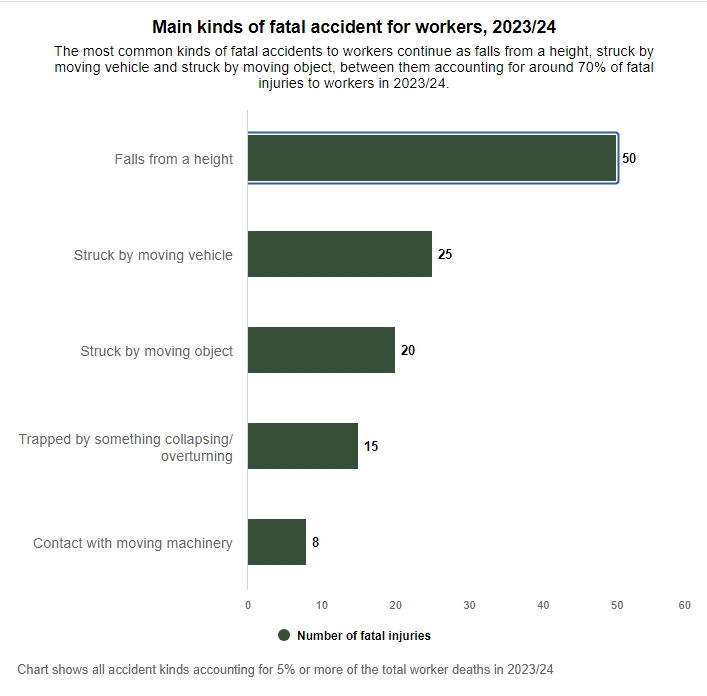Tragic Fall Highlights the Dangers of Working at Height
- Shalini Singh
- Dec 6, 2024
- 3 min read
Updated: Dec 12, 2024
A Life-Altering Accident
In a sobering reminder of the perils of working at height, a recent incident has underscored the critical need for proper safety measures and training.

Andrew, an experienced worker, fell from scaffolding during a routine job, leaving his life forever changed. The fall caused severe spinal cord injuries, leaving him paralysed with only limited movement in his hands and arms.
Andrew spent five gruelling months in hospital, adjusting to a reality no one should face. His home life has been upended—he now resides in the downstairs area, separate from his wife and daughters, and relies on constant assistance for even the most basic tasks. His story is not just about the physical toll but also the emotional and financial strain on his family. This tragedy serves as a wake-up call for all industries to prioritise safety at height.
Statistics: The Stark Reality of Falls from Height
Falls from height remain one of the leading causes of workplace fatalities and serious injuries in the UK. According to the latest figures:

In 2023/2024 alone, 50 fatalities occurred due to falls from height, contributing
significantly to the 138 total workplace-related deaths in the period.
Non-fatal injuries, including major trauma, are also disproportionately caused by falls, with industries like construction, maintenance, and agriculture at particularly high risk.
Key takeaways from the data include:
Fatality and Injury Rates
Falls from height consistently account for the highest proportion of workplace fatalities.
Non-fatal injuries often result from inadequate precautions or a lack of proper equipment.
High-Risk Sectors
Construction, maintenance, and agriculture face the most incidents, driven by tasks like working on ladders, scaffolds, and fragile roofs.
Regulatory Focus
The Work at Height Regulations 2005 emphasise planning, risk assessment, and appropriate safety equipment to mitigate these risks.
The Importance of Competency in Work at Height

At the heart of work-at-height safety lies competency—the combination of knowledge,
experience, and training needed to perform tasks safely. Competent workers can:
Assess risks effectively, identifying potential hazards before they escalate.
Use equipment properly, ensuring harnesses, scaffolds, and other tools are in good working condition and used as intended.
Respond to emergencies with confidence, minimising harm in worst-case scenarios.
For employers, investing in regular training and familiarising workers with the latest safety protocols isn’t just a legal obligation—it’s a moral imperative.
Consequences of Non-Compliance

Failing to adhere to safety standards like the Work at Height Regulations 2005 can have dire consequences. In Andrew’s case, an investigation by the Health and Safety Executive
(HSE) revealed significant lapses:
Paul Freeman Limited, the employer, failed to properly plan the work at height.
There were no measures in place to prevent falls, such as guardrails or harnesses.
Andrew had not been given clear instructions on how to safely carry out the task.
As a result, the company pleaded guilty to breaching Section 2(1) of the Health and Safety at Work Act 1974. Paul Freeman Limited was fined £40,000 and ordered to pay an additional £6,263 in costs.
These legal and financial penalties are just the beginning. The human cost—seen in Andrew’s life-altering injuries—is immeasurable and highlights the urgent need for employers to take their safety responsibilities seriously.
Building a Culture of Safety

Preventing incidents like Andrew’s requires a proactive approach to workplace safety. Employers and workers must collaborate to foster a culture where safety is a shared responsibility. Practical steps include:
Regular inspections to identify and mitigate risks.
Open communication to address safety concerns before they lead to accidents.
Ongoing training to ensure workers are equipped with up-to-date knowledge and skills.
By embracing these practices, employers and employees alike can comply with regulations, prevent accidents, and save lives.
The Path Forward
Andrew’s life-altering accident is a stark reminder of what’s at stake when safety protocols are overlooked. It’s a call to action for every industry to prioritise the well-being of its workforce, especially in high-risk environments.
At Base Solutions Ltd, we are committed to preventing such tragedies. Our comprehensive Work at Height Online Training Course is designed to equip workers with the skills and knowledge to work safely at height.
From risk assessments to emergency responses, our course ensures workers are competent, confident, and compliant.
Don’t wait for tragedy to strike. Take the first step towards a safer workplace today. Explore our online course here. Together, we can save lives and prevent life-altering accidents like Andrew’s.
Safety isn’t just about regulations—it’s about protecting people and their futures.
.png)


Comments